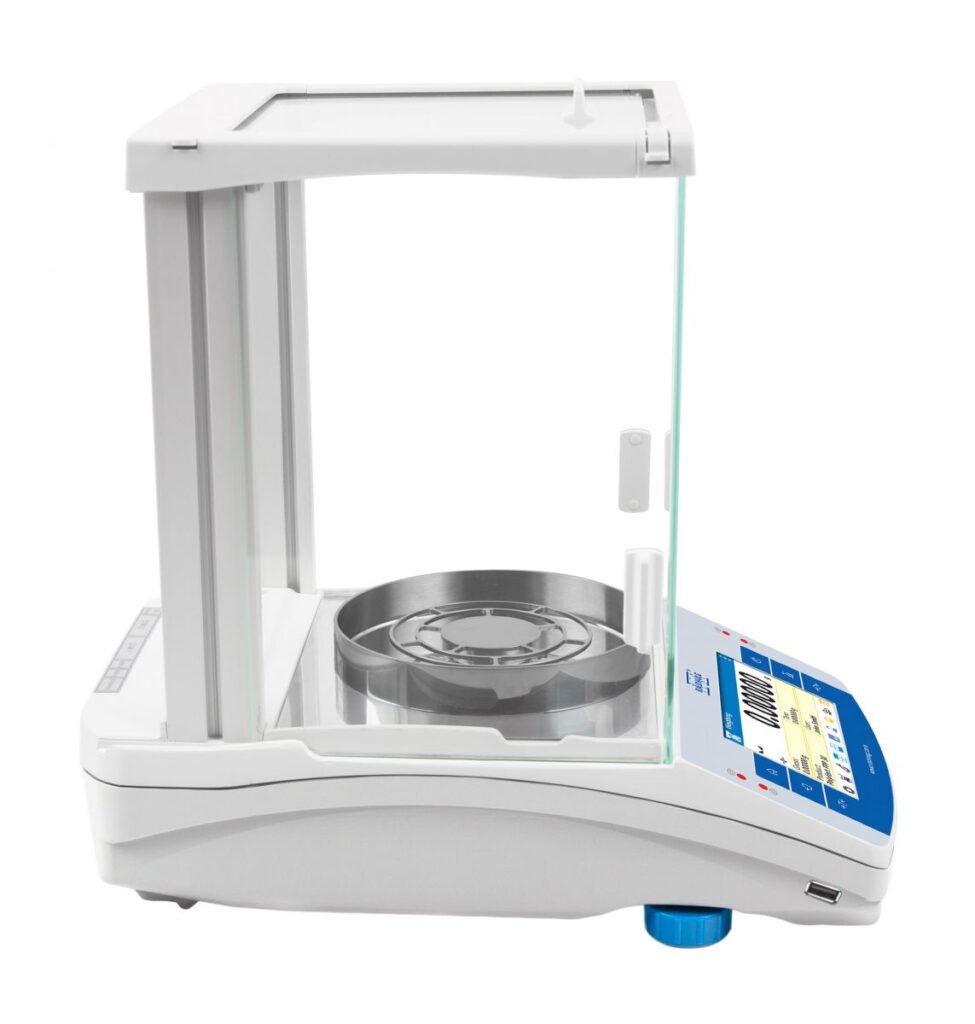“What Should Be Taken into Account While Selecting an Analytical Balance?” and “Which RADWAG Analytical Balance to Choose?” are the most frequently asked questions. In this article, our expert will discuss the possible criteria for choosing an analytical balance, but before doing so, he will explain what an analytical balance is and what it is used for.
Analytical Balance, What Is It and What Is It Used For?
A very good repeatability (as low as 0.005 mg), high readability (even 0.01 mg) and high resolution (52,000,000 divisions) are the main features of an analytical balance. What is this high resolution? Imagine wanting to measure the distance from Copenhagen to Oslo, which is about 600 km, with such an accurate device. Our measuring instrument would have to calculate this distance with the accuracy of 1 mm (0.000 000 006 km). Do you understand now?
This measuring device is intended for weighing small masses and, as a type of laboratory balance, is widely used in pharmaceutical, physical, chemical, biological, medical and other laboratories. It is worth mentioning that the ambient conditions for using an analytical balance are not as demanding as for a microbalance, as we write about in our article: [link]
What Should Be Taken into Account While Selecting an Analytical Balance?
The conditions in the weighing room, such as temperature and humidity, determine the operation of the balance. If they comply with the requirements specified by the manufacturer of the equipment, it works properly; if not, its operation is incorrect. Once you have ensured that the conditions in the laboratory are optimal for a balance, you can focus on the performance of the instrument itself, functionality, dedicated accessories, compliance with regulations (legalisation, the 21 CFR law and the USP), services (calibration, qualification, and validation), compatibility with other instruments, ease of use and ergonomics, service offer and price.
A. Analytical Balance Parameters
- Analytical Balance Repeatability
Repeatability is a balance ability to provide identical result for one and the same load weighed several times under identical conditions.
Repeatability is expressed as a standard deviation, i.e. SD. The best measurement precision is indicated by a small SD, so for an analytical balance look for values in the order of 0.005 mg. This condition is met by RADWAG analytical balances.
Our product range includes the following series of analytical balances: R2 PLUS, X2 PLUS and 4Y PLUS & 4Y.A PLUS. The R2 PLUS series analytical balances, thanks to their new design, obtain a weighing accuracy equal to the lowest minimum weight values in the world, i.e. 0.012 mg. The X2 PLUS series analytical balances feature a unique repeatability, equal to the readability, of 0.01 mg. What is more, the 4Y PLUS and 4Y.A PLUS series analytical balances have the best repeatability values,
- Analytical Balance Linearity
Linearity is a deviation of real balance characteristics from a straight line connecting two points: zero and maximum. Since there is no ideal balance in real life, its characteristics will never be a straight line, however a straight line is a desired standard. Linearity corresponds to the maximum indication error in a particular measuring point.
For analytical balances of the R2 PLUS and X2 PLUS series, linearity errors are minimised to no more than ± 0.05 mg. The analytical balances of the 4Y PLUS and 4Y.A PLUS series, thanks to their innovative design, feature an even smaller linearity error of ± 0.03 mg.
- Minimum Weight of the Analytical Balance
Minimum Weight is expressed by low threshold of the balance weighing range, below which conditions required for precise weighing regulated by the USP (United States Pharmacopeia) are not met. Your analytical balance must correspond to the minimum weight value specified in your weighing process.
Minimum weight depends on repeatability, therefore RADWAG analytical balances of the R2 PLUS series can guarantee the minimum weight of 24 mg. In the X2 PLUS balances, where repeatability is even better, the minimum weight is reduced to as little as 20 mg, while in the 4Y PLUS and 4Y.A PLUS balances with unrivalled repeatability, thanks to the additional Smart Min Weight function, the minimum weight is as low as 10 mg. To clarify, Smart Min Weight allows the range resolution to be automatically adjusted to the mass to be weighed, resulting in a 30% improvement in the minimum weight parameter.
- Analytical Balance Stabilisation Time
Balance stabilisation time is the time interval during which a stable measurement is obtained. It is measured from the very moment a load is placed on the pan to the moment a stable indication is read. The analytical balance allows you to adjust the stabilisation time to suit your weighing process.
Before you choose an analytical balance, you need to decide what is more important to you: measurement precision or measurement speed. If the priority is precision then pay attention to the repeatability when buying an instrument, in the case when speed is crucial, make sure that the stabilisation time is right. Remember, the shortest stabilisation time does not mean the best weighing results, i.e. the highest precision.
RADWAG product range of analytical balances includes devices with 2-second stabilisation time. These are the R2 PLUS and X2 PLUS series balances. In their case, the stabilisation time depends on the external conditions and the dynamics of placing the weight on the weighing pan and has been determined for an optimal profile that allows measurements to be obtained in a very short time. The 4Y PLUS series balances, i.e. devices with higher reading accuracy, for obvious reasons need more time to obtain stable measurement. On the other hand, in the 4Y.F series balances for filter weighing, despite the large size of weighed filters (with the diameter of even 47 mm), this time has been shortened to the minimum value of approx. 5 seconds, thanks to the specially designed automatically open weighing chamber.
Balance Adjustment aims to correct indication error and as a result to maximally increase balance precision. It consists in comparison of the weighing result of an internal balance weight with its previously determined value.
The optimum solution for the user of an analytical balance is 2-Point Adjustment, because it:
- enables to obtain the highest measurement precision within the whole weighing range;
- limits linearity errors to the very minimum;
- eliminates errors due to ambient conditions change and gravity coefficient.
RADWAG analytical balances of the 4Y.A PLUS series feature adjustment in two measuring points.
- Analytical Balance with an Integrated Antistatic Ionizer/ External Antistatic Ionizer
The best choice is the analytical balance equipped with an antistatic ionizer, which neutralizes electrostatic charges of the sample. If, in addition to the ionizer, the balance has an automatically open weighing chamber, it will neutralize the effect of the charges on each weighing process, i.e. each time the chamber is opened.
The electrostatic charge of the sample may affect the balance and prevent the sample from being weighed. The built-in ionizer will neutralise the charge and allow the sample to be weighed, and the inside of the weighing chamber covered with a special antistatic layer will reduce the electrostatic charges to the minimum.
RADWAG 4Y.A PLUS series of analytical balances are, by standard, equipped with an antistatic ionizer integrated with the weighing chamber. Balances of the R2 PLUS, X2 PLUS and 4Y PLUS series can be equipped with an additional external ionizer, which can be used with several balances depending on your needs. The external ionizer works on the same principle as the integrated one.
- Analytical Balance Weighing Chamber
RADWAG analytical balances, depending on the series, are equipped with a manual or an automatic weighing chamber. The latter, thanks to the infrared (IR) sensors, can be opened with gestures. The contactless opening and closing of the weighing chamber eliminates any vibrations that interfere with measurements, allows you to define how wide the door is to be open, and improves ergonomics. Analytical balances of the 4Y.A PLUS series are equipped with the automatic weighing chamber.
In addition, pay attention to whether the weighing chamber of the balance you choose is easily removable. This is a very practical solution as the quick and tool-free disassembly of the chamber makes it easy to clean and to transport, and install the balance in special weighing rooms such as a glove box or laminar chamber. An easily removable weighing chamber is a standard feature of all RADWAG analytical balances.
- Analytical Balance Levelling
A correctly levelled balance gives precise and repeatable readings. RADWAG analytical balances can be levelled:
- manually,
- semi-automatically (LevelSENSING System),
- automatically (Reflex Level System; auto-levelling).
In the case of manual balance levelling, quick control of correct levelling is possible thanks to the level indicator placed at the balance front. During semi-automatic levelling, the balance prompts the user how to adjust the level indication. This makes LevelSENSING SYSTEM more user-friendly and less time-consuming than manual levelling.
The most convenient and fastest way is auto-levelling, which not only guarantees the ideal position of the measuring system and provides the most precise measurement results, but also alerts when the balance is out of level. Furthermore, the fact that the balance is correctly levelled is confirmed in the calibration report, which is a prerequisite for the use of the instrument in, for example, the pharmaceutical industry.
Manual levelling is used in the R2 PLUS series analytical balances, semi-automatic – in the X2 PLUS and 4Y PLUS series balances, and automatic – in the 4Y.A PLUS series balances.
- Analytical Balance – Working Modes and Functions
RADWAG analytical balances may vary in terms of working modes, therefore it is worth choosing such a device which has functions adjusted to your needs.
RADWAG as one of a few manufacturers of electronic scales offers, free of charge, full access to working modes within a given series. Analytical balances of the R2 PLUS series, apart from the basic function, which is weighing, have additional working modes: dosing, percent weighing, totalizing, parts counting, peak hold, statistics, checkweighing, animal weighing, density determination of liquids and solids, and GLP procedures. RADWAG X2 PLUS series analytical balances, apart from the above-mentioned working modes and functions, additionally ensure: basic formulations, ambient conditions monitoring, displaying several weighing units simultaneously, ALIBI memory, cooperation with titrators, compliance with 21 CFR part 11, creating standard and non-standard printouts, dedicated permission levels, fully-customizable display.
In turn, the balances of the 4Y PLUS and 4Y.A PLUS series, in addition to the above working modes and functions, are the only ones in the world to have integrated ambient conditions module (temperature, humidity, atmospheric air and vibration sensors), Impact Detection (impact sensor), ambient conditions sensors (temperature, humidity, atmospheric air, and gravitation sensor), full autotest to be carried out by the customer or, remotely, by the manufacturer, compliance with 21 CFR part 11 with no database limits, pipette calibration, air buoyancy correction, differential weighing, advanced formulations, packaged goods control and statistical quality control (SQC).
C. Analytical Balance Accessories
- Weighing Tables Intended for the Analytical Balance
The measurement readability is affected not only by the quality and sophistication of the balance, but also by the ambient conditions in the weighing room. Among other things, errors in mass measurement are caused by ground vibrations, which you can eliminate by using an anti-vibration weighing table.
Weighing tables differ in material they are made of, their construction and intended use. We offer tables with a granite top and professional weighing workstations. Tables and weighing workstations can be used for all series of RADWAG analytical balances.
- External Software Intended for the Analytical Balance
Software is required to ensure that the balances, in addition to fulfilling their basic function, collect, process and transmit data. Software intended for RADWAG analytical balances differs depending on the series. In the case of the R2 PLUS and X2 PLUS series, it is: R-LAB, E2R Weighing Records, Alibi Reader, RAD-KEY, R.Barcode, RADWAG Development Studio, RADWAG Connect, Labview Driver and R Panel, and in the case of the 4Y PLUS and 4Y.A PLUS series it is additionally: R02 Label Editor, Pipettes, Audit Trail Reader, Parameters Editor, RADWAG Remote Desktop, and RES communication protocol for support of ERP and LIMS systems.
- Miscellaneous Accessories Intended for the Analytical Balance
The availability of dedicated accessories is another important criterion for selecting a balance. For RADWAG analytical balances of the R2 PLUS and X2 PLUS series you can choose from: holders for laboratory vessels, KIT-85 for density determination of solids and liquids, a rack for under-pan weighing, and the DJ-04 antistatic ionizer. In case of the 4Y PLUS balance these are: the DJ-04 antistatic ionizer and the THB-S or THB-P ambient conditions sensors, and for the 4Y.A PLUS balance additionally: the XA17 and A100 adapters for pipette calibration, and the automatic tablet feeder.
In order to maintain measurement traceability, each RADWAG balance is equipped with appropriate mass standards of classes ranging from E1 to M2. Additionally, you can purchase tweezers, brushes, and gloves for all instruments.
D. Compatibility with Other Devices
The analytical balance can communicate with multiple peripherals. The R2 PLUS series analytical balances by RADWAG connect with a computer, printers (Epson dot matrix and thermal printers), barcode scanners, an additional LCD, and mobile devices based on Android and iOS systems, and the X2 PLUS series balances additionally connect with an ambient conditions module and a titrator. The 4Y PLUS and 4Y.A PLUS series balances offer versatile communication with peripherals available on the market, and the interfaces unique in laboratory balances (e.g. inputs/outputs) give them the ability to communicate with PLCs. Balances of this series work with the above-mentioned types of printers, and additionally with PCL printers, an automatic feeder, and QR code scanners.
E. Intuitive Operation and Ergonomics
RADWAG analytical balances are user-friendly – this is what our customers say about them, especially those who used to work with weighing instruments from other manufacturers. Our analytical balances are equipped with a colour touch screen of optimum size. They enable easy access to weighing functions and applications, and full customization of the weighing terminal to ensure ergonomic operation.
Ergonomics can be easily illustrated on the example of the 4Y.A PLUS series analytical balances by RADWAG. We understand it as an easy measurement readout, full customization, automatically open weighing chamber, messages informing the operator about correct weighing, set of tools for self-testing of the balance, and gesture sensors.
F. Fast Service of the Analytical Balance
According to current legislation, measuring equipment must be supervised at all times, so the brand you choose should guarantee you a professional and fast service. RADWAG offers: repairs, spare parts, after-sales support, advice, technical inspection, and maintenance. Of course, these services apply to RADWAG analytical balances of all series.
G. Analytical Balance Price
The prices for RADWAG analytical balances vary depending on the series. We start at R2 level – for those who want a lot and at a reasonable price, and finish at 4Y.A PLUS – for those who want everything.
Do you have any questions? Is something unclear? Our specialist will be happy to advise you which RADWAG analytical balance will meet your expectations.
![]()










